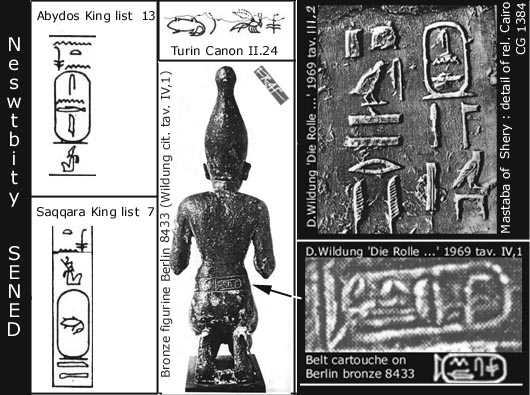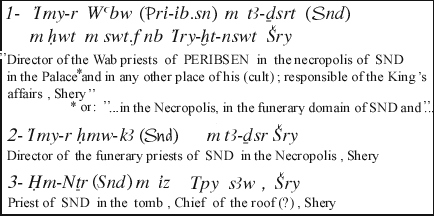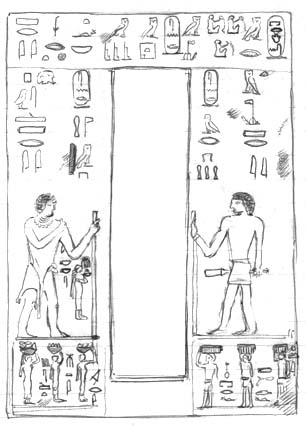
- Neswt-bity Sened is attested on the NK king-lists (Saqqara list
in the Tomb of Tjwloy, Abydos list in the temple of Sethi I and Royal Papyrus
of Turin-cat.1874) univoquely as fifth ruler of the second dynasty : he undoubtly
followed Wadjnes as the Saqqara, Abydos and Turin documents attest, but about
his follower's identity there's less concordance: respectively Neferkara,
Djadjatepy (Khasekhemwy) and 'Aaka are reported on these sources.
- Another New Kingdom document mentioning the Neswt-bity Sened is the Berlin (3038) Medical Papyrus (very similar in contents to the Papyrus Ebers) which is said to have belonged (15,1 1-3) to king Hspty (or Khasty / Zemty = Den Ist dyn.) who would have given it to his successor Send (it's historically impossible: at least 7 kings reigned between the two-c.120 y.). Here the name of Sened is written with the Hieroglyph Gard. G54 (see D. Wildung 1969 p. 45-51) .
- A late period inscription naming Sened (in the cartouche) is on a bronze statuette belt (XXVI dyn. ?) (Berlin n. 8433); the writing is placed in the part of the belt behind the back of the figure and the name is in the archaic fashion variant with the three signs S-n-d (see D. Wildung cit. p.51, tav. IV,1; p. 45-51 for other discussions on Wng, Snd, Peribsen, Sekhemib).
Another later time mention of Sened was on the coffin of an anonymous early XVIII Dyn. concubine of king Ahmose (foundator of 18th Dynasty) at Dra Abu-l-Naga (T100.2): the inscriptions of this and of more -now lost- coffins from that necropolis were drawn by Luigi Vassalli (who worked many years for A. Mariette: 1859-1881: cf. this link and F. Tiradritti's 2006b publication in Bibliography). In 1862-63 Vassalli drew this T100 coffin nr. 2 on which a short king list was inscribed with four kings on one side and four on the other one: Sened - unidentified name - Antef - Nebhepetra Montuhotep /// Sesostris (II) - Sesostris (III) - Sekhaenra (User-Montu, late 13rd Dyn.) - Ahmose. The prominence given to Sened on this inscription is at least surprising (cf. Tiradritti 2006a).
Old Kingdom objects- Noteworthy is a finding (documented in Orientalia 57, 1988 p. 330) from the area of the Ninetjer's galleries, south of the south wall of the Djoser's complex (Saqqara): a mudbrick with the cartouche name of the king NeferSenedjRa is a valid indication of the presence of the tomb or of a funerary cult shrine of this king in that area.
- Whether of Second dynasty date, this would be the most ancient cartouche-royal name ever found, predating the cartouches on the seals of Neferkaseker, Peribsen and those of the Third Dynasty Nebka and Huni-Niswteh.
- Another inscription of Nswtbity S-n-d (probabily of third dyn. date) has been found on a bowl reused in the funerary temple of Khaefra at Giza (Steindorff in Holscher 'Das Grabdenkmal des Chephren' 1912 p.106 'schale'; T.Wilkinson 'E.D.E.' 1999 p. 88, erroneously reports a 'reused block' with S. name).
- Alike his predecessor , Sened is only known from Lower Egyptian findings (PM V, 90 citing Shery in Abydos is an error);
- As for Weneg, only one tomb in Saqqara produced material of this ruler: but the S 3014 (unpublished) was surely coeval of Weneg, whereas the Mastaba MM B3, which had inscriptions with the cartouche of Sened (see fig.), belonged to a dignitary of the middle or end of the fourth dynasty, Shery. (see bibl.)
- The titles of Shery are translated in the fig.2 ; some scholars have taken these inscriptions as proof of the identity of Sened with Peribsen (> Barta Z.A.S. 108, 1981) and the same name Snd, translated 'The Frightful' , would be a New Kingdom offensive appellative to name the 'heretic' Peribsen; indeed the name is better interpreted as 'The one who frightens' or 'The feared one' and Sened and Peribsen are much more probably two distinct rulers.
- A cartouche of Peribsen on a cylinder sealing in Milan, furthermore shows that Sened could not be the Neswtbity of the Seth-Peribsen; the latter must have reigned from one to four reigns after Sened , circa 10-20 years later (but see also below).
- There's a wide difference between the sources available for Peribsen / Khasekhem and those related to the first five kings of the Second Dynasty.
- The fact that an overseer of the Wab-riests of Peribsen in the (Saqqara) necropolis did exist in the fourth dynasty tells a lot about the lacks in our knowledge of the second dynasty kings' presence in this site; the last rulers (Sekhemib, Peribsen and Khasekhemwy) are very very scarcely known at Saqqara (but this may depend on chance or on third dyn. complex building).
The tomb of Sened has not been found and it has been proposed, as for other second dynasty kings, that the galleries under the Western massif of the Djoser's funerary complex at Saqqara could have belonged to the tomb of Sened too.- An alternative location is the area south of the monuments A and B (Htpsekhemwy-Nebra and Ninetjer' s substructures), east of Sekhemhet' s complex (Saqqara) in the new kingdom necropolis where is located the tomb of Horemheb.
In early year 2002, Dr. Raven and Van Walsem of Leiden University, have excavared the tomb and galleries of the 18th Dynasty tomb of Meryneith-Meryra (high priest of Aton at Memphis and Akhetaton -in Akhenaton's reign-); the subterranean parts proved to be almost all from reused from substructures originally of a Second Dynasty tomb.
There are three clues to be considered: 1) Shery's directed funerary-cult of Sened suggests that the latter's tomb was at Saqqara (cf. Kaiser, in: GM 122, 1991); 2) Wneg must have been a relevant individual during Ninetjer's reign (if not his own son), espacially if he really was the Wr-Maaw Wadj-sen attested on stone vessels ink-inscriptions from Djoser's pyramid. Therefore it's probable that might have chosen to build his tomb closer to the one of his prestigious predecessor. 3) The cited mudbrick inscription with the cartouche name Nefer-Sened-Ra (which could be archaic as well as Ramesside) is surely a sign of the closeness of a royal monument of Sened (who undoubtly is the same as Nefersenedjra) to the point of its finding, namely the area around the tomb in object.- (Note: the already cited art. in Orientalia 57, 1988 p.330 does not precise the exact writing of the name Nefer-Senedj-Ra).
Returning to the Shery' s Mariette Mastaba B3 in the memphite necropolis, we must say that fragments of its walls' reliefs are spread in various museums (W.S. Smith H.E.S.P.O.K. 1949 p. 173): Cairo(1384), Florence (2554), London (B.M.1192), Oxford (Ashm.Mus. 794) and Aix en Provence (Moret,1922,is a full study dedicated to these pieces) (Wildung cit. p.47 n4).- [The inscriptions here presented have been drawn by me from a chalk copy in the Museo Archeologico,Napoli,of the original false door 1384 in the Cairo Museum]. (Note: for other discussions on Shery 's titles see the page of Peribsen)
- The Saqqara Mastaba B3 location is lost but it must be in the area, 350 m. north of Djoser's temenos where are other IV th dynasty tombs, like the Leps. 6 of Metjen. There are from 350 to 1500 m of distance from the possible sites of Sened tomb.
- W.S. Smith (op.cit) doubted between the chronological collocation of Shery to the middle or the end of the fourth dynasty .
- [ Helck dated the Mastaba of Shery to the reign of Khaefra (Khefren); cfr. i.e. id. in: MDAIK 15, 1957 p. 93 . Also see Weill (p.33,330) and Moret (p. 298) -loc.cit. below- did ].
- Anyhow what is sure is that a cult of two kings of the mid-end second dynasty was kept until the fourth , for more than 150 years, in Saqqara : thence (apart from the conclusions we can get out for Peribsen , who was indeed not badly considered at the time of the Old kingdom) there seems to be a remote probability that Sened and Peribsen, whose cult shrines in Saqqara laid nearby to each other, might also have been two successive kings (as suggested by Grdseloff art.cit. 294); but in this case at least 3 Kings (Neferkara-Aaka, Neferkaseker, Sekhemib-Perenmaat) wouln't find collocation in the dynasty.
- I think, as I ve said above, that the two rulers on the Shery false door inscripion can be fairly certainly separated by 10-20 years during which some ephemeral memphite kings and an Abydene one (Sekhemib) reigned, until Peribsen' s accession .
- The possibility of a break or a civil war between Upper and Lower Egypt at this time will be treated in the Peribsen page;
- suffice here to say that there's a minor probability of contemporary rulers in Memphis and Abydos and, for me, there was no catastrophic war or extraordinary event in this period but only a crisis, as in the Third and Fourth dynasties, that would have been originated by succession struggles, brief reigns, economic or environmental problems whose effects are the scarcity of documentation, the weak state authority and presence in the provinces, and perhaps also the Peribsen' s religious 'reforms'.
- In an article of the 1979 (Z.A.S. 106 p. 120-32) W. Helck discussed the chronology of the inscriptions on the stone vessels published by Lacau-Lauer in their study of the Djoser' s complex; he concluded (cit. p.132) that a pacific contemporary reigns' succession followed Ninetjer's reign with the Up.Eg. Peribsen,Sekhemib and Khasekhem roughly coeval of Wneg , Sened , Nwbnefer and possibly a couple of other kings reigning in Low.Egypt; then the country was reunified by Khasekhem(wy) ;
- Moreover the Shery inscriptions not only didn't mean that Sened and Peribsen were the same king, but didn't neither allude to a reign of Peribsen in Lower Egypt. But his mention alone can be taken as a proof of good relations between the two capitals of Egypt during the middle of the second dynasty; perhaps only the later part of this period knew some struggles .
- In a study of P. Kaplony (M.D.A.I.K. 20 , 1965 p. 1 ff), about 'steingefassen' too, he lists the sources past Ninetjer in this order : Wng (10 examples), Nfr-nb (2), Snd (1), Prj-ib-sn (2), Skhm-ib /Prj-n-maat (10), Khaj-sekhemwy (11); interesting are the positions suggested for Nfr-nb (Nwbnfr) and Sekhemib-Perenmaat ; moreover the Sened gefassaufinschrift is the only source for this king from his own reign (with the 'Nefersenedjra' brick ?).
- Finally D. Wildung (op.cit. p. 48) concluded his paragraph on the subject writing that " in ihm (Seth - Peribsen) nicht einen selbstandigen Herrscher zu sehen,sondern einen lokal gebundenen Aspekt des zusammen mit ihm in den Inschriften genannten Snd, der uns unter diesem Namen noch mehrfach in der spatern Uberlieferung begegnen wird ".
Conclusions- We can conclude that, at the present stage of our knowledge, it can't be surely said whether Sened and Peribsen were:
- 1a) two different kings separated by 5-20 years of some ephemeral rulers' reigns
- 1b) two different kings, the latter immediately following the former (Grdseloff cit.p. 294 hypothesized a father to son relation)
- 2) two different contemporary kings , more or less pacifically reigning one in Memphis and the other in Abydos
- 3) the same king in his Lower Egyptian 'Political' name-Snd- and the Upper Egyptian 'religious' Seth (=Horus) name Peribsen (but this is more than a remote hypothesis which we could have also omitted, in primis for the writing in Shery's tomb).
In support of the last hypothesis there would be the similarity in the meaning of the two royal names: Seth/Ash Per-ib-sen is based around the sentence which would mean "He who scares them" [lit. Per(.j) jb.sen = I make their soul get lost] and Sened means "to Frighten" (cf. J.P. Pätznick, Die Siegelabrollungen und Rollsiegel der Stadt Elephantine im 3. Jahrtausend v. Chr., Oxford, 2005, 64, n. 673). The meanings are both in line with the violent character of the desert god (although the eminently malevolent behaviour of this deity is mostly a later period feature).
The Annals reconstructions by some eminent scholars allow for c. 40 years between the death of Ninetjer and the accession of Khasekhem; this period internal history is very uncertain as we have seen and will see; considering the sources quantity we are inclined to think that fourty years fit better for a 'successive-kings' hypothesis than for a 'contemporary-kings' one.- Besides the cartouche neswt-bity name of Peribsen on the Milan Civ. Racc. cylinder seal (R.A.N. E 997.02.01) ought to exclude the hypothesis 3. I tend to favour the 1a theory of two different and not successive kings, but it can't be taken for certain .
- Another New Kingdom document mentioning the Neswt-bity Sened is the Berlin (3038) Medical Papyrus (very similar in contents to the Papyrus Ebers) which is said to have belonged (15,1 1-3) to king Hspty (or Khasty / Zemty = Den Ist dyn.) who would have given it to his successor Send (it's historically impossible: at least 7 kings reigned between the two-c.120 y.). Here the name of Sened is written with the Hieroglyph Gard. G54 (see D. Wildung 1969 p. 45-51) .

Click on here to see the photo of the Cairo false door
(Thanks to John D. Degreef)


N. 3 read 'Prophet of Sened in the tomb's gate (rw.t iz) , Chief of the Roof, Shery 
False door of Shery, Cairo 1384
- Bibliography
- Shery : A.Moret 'Fragments du Mastaba de Shery, pretre des Rois Peribsen et Send' Fondation Piot 25, Paris 1922 ; A.Mariette 'Les Mastabas des l' Ancient Empire' 1889 p. 92-4; R. Weill 'La IIe et la IIIe dynasties' 1908 p. 35, 333; B.Grdseloff in A.S.A.E. 44, 1944 p.294 ; W.S.Smith 'A History of Eg. Sculpture and Painting in the Old Kingdom' p.173' ; W.Kaiser 'Zur Nennung von Sened und Peribsen in Sakkara B3' G.M 122, 1991 p. 49-55; W.Helck 'Thinitenzeit' p. 103-6;
- SND: A.Dodson 'The Mysterious Second Dynasty' KMT 7:2, 1996 p.24; Wilkinson cit.above; Orientalia 57, 1988 p. 330 ; D.Wildung 'Die Rolle Agyptischer Konige im Bewusstein ihrer Nachwelt' 1969 p. 45-51 for Sened and for Shery's titles; Vercoutter 'L'Egypte et la Vallee du Nil' t. I.
For the inscription on the XVIII coffin with a short king list headed by Sened: Francesco Tiradritti, Un Sigillo delle Civiche Raccolte Archeologiche di Milano con il cartiglio di Peribsen, in: P. Minà (ed.), Imagines et Iura personarum. L'uomo nell'Egitto antico. Atti del IX Congresso... Palermo 2004 (FS S. Donadoni). 257-267 (2006a). Id., Luigi Vassalli and the Archaeological Season at Western Thebes (1862-63), in print (2006b).
- Shery : A.Moret 'Fragments du Mastaba de Shery, pretre des Rois Peribsen et Send' Fondation Piot 25, Paris 1922 ; A.Mariette 'Les Mastabas des l' Ancient Empire' 1889 p. 92-4; R. Weill 'La IIe et la IIIe dynasties' 1908 p. 35, 333; B.Grdseloff in A.S.A.E. 44, 1944 p.294 ; W.S.Smith 'A History of Eg. Sculpture and Painting in the Old Kingdom' p.173' ; W.Kaiser 'Zur Nennung von Sened und Peribsen in Sakkara B3' G.M 122, 1991 p. 49-55; W.Helck 'Thinitenzeit' p. 103-6;
|
|
FRANCESCO RAFFAELE EGYPTOLOGY |
|